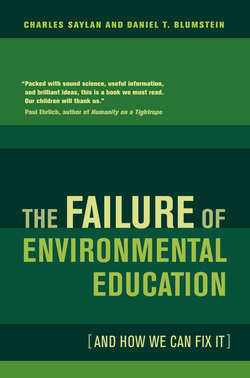Читать книгу The Failure of Environmental Education (And How We Can Fix It) - Charles Saylan - Страница 6
На сайте Литреса книга снята с продажи.
ОглавлениеPREFACE
There are noticeably fewer places these days where one can experience the immensity of nature, where one can feel alone and far from the societal order that humanity seems driven to impose on the random wilderness. It is harder to hear the wind howl across some distant ridge, as trees are fewer now, felled by ever-expanding and efficient industry. Not long ago, within the scope of the authors' personal memories, one might have ventured into the wilderness and found no trace of humans. Today, however, humanity's footprint is almost everywhere. Out in the woods are anonymous fences that mask the grand exfoliation of mining, hydroelectric plants, or oil pipelines. Gazing up from almost anywhere, one sees jet contrails filling the sky with the graffiti of human presence. Looking deeper into the natural world reveals changes in animal behavior and ecology caused by the long arm of anthropogenic effects, like the presence of human toxins in the fat of top predators that live in remote places where humans are never encountered. Even the wilderness areas our governments set aside for protection have diminished over the years under the prevailing belief that growth and development are synonymous with success.
From childhood, we each had the privilege of experiencing the freedom that roaming the wilderness offers, as hikers and mountaineers, as skiers and sailors, as biologists and teachers. That freedom sowed in us the seed of a profound respect for and love of nature. Our concept of nature was as immense as the outdoors, as vast as the horizon, as deep as outer space.
When we were young, we were taught that the population of our planet was just under three billion, a number that seemed incomprehensibly large to a fourth grader. In significantly less than a lifetime, however, the population has more than doubled and may soon double again. Sadly, the space we enjoyed as children is shrinking, and the wild unexplored places that inspired us so deeply are now mostly gone.
We have witnessed growth unprecedented in the history of our species and our planet, initially with a sense of pride and wonder at technologies that seemed like something out of science fiction. But as these advances became real and accessible, our wonder became clouded with uncomfortable foreboding. The irrepressible nature we enjoyed and had taken for granted seemed increasingly threatened by unlikely sources that, just a few years earlier, were touted as the cutting edge of humankind's progress. Industry, development, better living, travel, and consumerism, to name a few, started revealing their unforeseen ramifications. Nobody's fault, really. Something, we hoped, that could be addressed by focusing human ingenuity on the problems. After all, we all have an unwavering faith in our collective ability to solve problems by applying technology. Right?
But as time passed and we looked deeper into these issues, we found they were not just isolated problems easily corrected. We slowly began to believe that what was being uncovered was only the tip of an immense iceberg, the magnitude of which humanity still does not comprehend. And our faith in human ingenuity was confused and shaken. It was that very same ingenuity, for the most part, that brought about this assault on nature.
We are both fortunate to have grown up with abundant opportunity to experience the wilderness in many forms, and we care deeply and personally that the opportunities we enjoyed will not be lost to children of future generations. Our children. Your children. Nature is a humbling force that teaches us we are all part of a greater system. Whether one chooses to believe that the origins of such complexity are random or divine is unimportant. Nature, a very different nature, will persist as some new balance sorts itself out. Evolution will proceed. It is humanity's place in the balance that is threatened.
Our perspective emerges from a combination of our two diverse backgrounds: Blumstein as scientist and educator, and Saylan as entrepreneur and, later, director of an environmental nonprofit. This diversity helps us approach this subject in a novel way. Each of us has worked toward raising public awareness of environmental issues in different ways. We have written popular articles, given public talks, and designed and implemented educational programs, albeit on a relatively small scale. We have repeatedly followed available funding, sometimes reformatting our programs to fit grantor's parameters and carefully wording our evaluations of program effectiveness in ways that would not jeopardize future opportunities by seeming negative. From very different experiences, and for very different reasons, we both arrived at the stark conclusion that both environmental education in its current state, and the institutions responsible for its implementation, do not effectively provide what is necessary to turn the tide of environmental deterioration. Importantly, we believe that this failing has not been widely recognized.
We firmly believe that change is not only possible but within reach if all of us begin to look at the problems differently and accept the collective and individual responsibilities required for wise stewardship of our earth. This, however, is no easy task. We hope future generations will have fish to eat, unpolluted water to drink, and a rich web of vibrant ecosystem services. We hope future generations will hike, bike, sail, and explore and enjoy what we so enjoyed growing up: open spaces, biodiversity, nature's processes. We hope this book helps achieve this vision.
